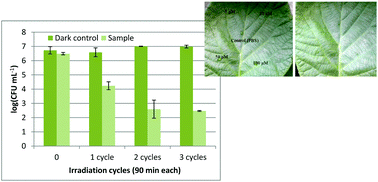当前位置:
X-MOL 学术
›
Photochem. Photobiol. Sci.
›
论文详情
Our official English website, www.x-mol.net, welcomes your
feedback! (Note: you will need to create a separate account there.)
An insight into the photodynamic approach versus copper formulations in the control of Pseudomonas syringae pv. actinidiae in kiwi plants
Photochemical & Photobiological Sciences ( IF 2.7 ) Pub Date : 2017-11-28 00:00:00 , DOI: 10.1039/c7pp00300e Vânia Jesus 1, 2, 3, 4 , Diana Martins 2, 3, 4, 5 , Tatiana Branco 1, 2, 3, 4 , Nádia Valério 1, 2, 3, 4 , Maria G. P. M. S. Neves 2, 3, 4, 5 , Maria A. F. Faustino 2, 3, 4, 5 , Luís Reis 6, 7, 8, 9, 10 , Esther Barreal 6, 7, 8, 9, 10 , Pedro P. Gallego 6, 7, 8, 9, 10 , Adelaide Almeida 1, 2, 3, 4
Photochemical & Photobiological Sciences ( IF 2.7 ) Pub Date : 2017-11-28 00:00:00 , DOI: 10.1039/c7pp00300e Vânia Jesus 1, 2, 3, 4 , Diana Martins 2, 3, 4, 5 , Tatiana Branco 1, 2, 3, 4 , Nádia Valério 1, 2, 3, 4 , Maria G. P. M. S. Neves 2, 3, 4, 5 , Maria A. F. Faustino 2, 3, 4, 5 , Luís Reis 6, 7, 8, 9, 10 , Esther Barreal 6, 7, 8, 9, 10 , Pedro P. Gallego 6, 7, 8, 9, 10 , Adelaide Almeida 1, 2, 3, 4
Affiliation

|
In the last decade, the worldwide production of kiwi fruit has been highly affected by Pseudomonas syringae pv. actinidiae (Psa), a phytopathogenic bacterium; this has led to severe economic losses that are seriously affecting the kiwi fruit trade. The available treatments for this disease are still scarce, with the most common involving frequently spraying the orchards with copper derivatives, in particular cuprous oxide (Cu2O). However, these copper formulations should be avoided due to their high toxicity; therefore, it is essential to search for new approaches for controlling Psa. Antimicrobial photodynamic therapy (aPDT) may be an alternative approach to inactivate Psa. aPDT consists in the use of a photosensitizer molecule (PS) that absorbs light and by transference of the excess of energy or electrons to molecular oxygen forms highly reactive oxygen species (ROS) that can affect different molecular targets, thus being very unlikely to lead to the development of microbe resistance. The aim of the present study was to evaluate the effectiveness of aPDT to photoinactivate Psa, using the porphyrin Tetra-Py+-Me and different light intensities. The degree of inactivation of Psa was assessed using the PS at 5.0 μM under low irradiance (4.0 mW cm−2). Afterward, ex vivo experiments, using artificially contaminated kiwi leaves, were conducted with a PS at 50 μM under 150 mW cm−2 and sunlight irradiation. A reduction of 6 log in the in vitro assays after 90 min of irradiation was observed. In the ex vivo tests, the decrease was lower, approximately 1.8 log reduction at an irradiance of 150 mW cm−2, 1.2 log at 4.0 mW cm−2, and 1.5 log under solar radiation. However, after three successive cycles of treatment under 150 mW cm−2, a 4 log inactivation was achieved. No negative effects were observed on leaves after treatment. Assays using Cu2O were also performed at the recommended concentration by law (50 g h L−1) and at concentrations 10 times lower, in which at both concentrations, Psa was efficiently inactivated (5 log inactivation) after a few minutes of treatment, but negative effects were observed on the leaves after treatment.
中文翻译:

深入了解光动力学方法与铜配方在丁香假单胞菌(Pseudomonas syringae pv)控制中的关系。藤梨猕猴桃植物
在过去的十年中,全球猕猴桃的生产受到丁香假单胞菌PV的高度影响。猕猴桃(Psa),一种植物致病性细菌;这导致了严重的经济损失,严重影响了奇异果贸易。该疾病的可用治疗方法仍然很少,最常见的治疗方法是经常在果园中喷洒铜衍生物,特别是氧化亚铜(Cu 2O)。但是,由于它们的高毒性,应避免使用这些铜配方。因此,寻找控制Psa的新方法至关重要。抗菌素光动力疗法(aPDT)可能是使Psa失活的另一种方法。aPDT在于使用吸收光的光敏剂分子(PS),并且通过将过量的能量或电子转移到分子氧上而形成可影响不同分子靶标的高反应性氧类(ROS),因此极不可能导致微生物抗性的发展。本研究的目的是使用卟啉Tetra-Py +-Me和不同的光强度。在低辐照度(4.0 mW cm -2)下,使用5.0μM的PS评估Psa的失活程度。之后,使用人工污染的猕猴桃叶在50 mM的PS下于150 mW cm -2并进行日光照射进行离体实验。辐照90分钟后,在体外测定中观察到6 log的减少。在离体测试中,降低幅度较小,在150 mW cm -2的辐照度下约为1.8 log ,在4.0 mW cm -2的辐照下为1.2 log,在太阳辐射下为1.5 log。然而,在150 mW cm -2下连续三个治疗周期后,实现了4 log灭活。处理后未观察到对叶片的负面影响。依法在推荐浓度(50 gh L -1)和低10倍的浓度下也进行了使用Cu 2 O的测定,其中在两种浓度下,经过几分钟的处理,Psa均被有效地灭活(5 log灭活),但是在处理后对叶子观察到了负面影响。
更新日期:2017-11-28
中文翻译:

深入了解光动力学方法与铜配方在丁香假单胞菌(Pseudomonas syringae pv)控制中的关系。藤梨猕猴桃植物
在过去的十年中,全球猕猴桃的生产受到丁香假单胞菌PV的高度影响。猕猴桃(Psa),一种植物致病性细菌;这导致了严重的经济损失,严重影响了奇异果贸易。该疾病的可用治疗方法仍然很少,最常见的治疗方法是经常在果园中喷洒铜衍生物,特别是氧化亚铜(Cu 2O)。但是,由于它们的高毒性,应避免使用这些铜配方。因此,寻找控制Psa的新方法至关重要。抗菌素光动力疗法(aPDT)可能是使Psa失活的另一种方法。aPDT在于使用吸收光的光敏剂分子(PS),并且通过将过量的能量或电子转移到分子氧上而形成可影响不同分子靶标的高反应性氧类(ROS),因此极不可能导致微生物抗性的发展。本研究的目的是使用卟啉Tetra-Py +-Me和不同的光强度。在低辐照度(4.0 mW cm -2)下,使用5.0μM的PS评估Psa的失活程度。之后,使用人工污染的猕猴桃叶在50 mM的PS下于150 mW cm -2并进行日光照射进行离体实验。辐照90分钟后,在体外测定中观察到6 log的减少。在离体测试中,降低幅度较小,在150 mW cm -2的辐照度下约为1.8 log ,在4.0 mW cm -2的辐照下为1.2 log,在太阳辐射下为1.5 log。然而,在150 mW cm -2下连续三个治疗周期后,实现了4 log灭活。处理后未观察到对叶片的负面影响。依法在推荐浓度(50 gh L -1)和低10倍的浓度下也进行了使用Cu 2 O的测定,其中在两种浓度下,经过几分钟的处理,Psa均被有效地灭活(5 log灭活),但是在处理后对叶子观察到了负面影响。











































 京公网安备 11010802027423号
京公网安备 11010802027423号